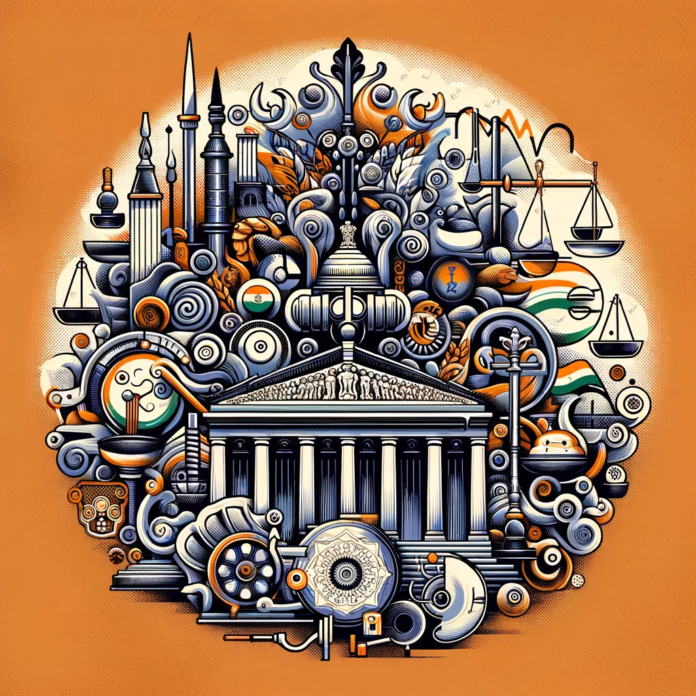Governance in India plays an essential role in determining the transformation of the nation. With goals like Atmanirbhar Bharat and the introduction of innovative technologies to improve the work efficiency and infrastructure in the public sector, the vision of good governance in India is becoming a reality.
India’s PM Narendra Modi also emphasized the importance of good governance and re-iterated Bal Gangadhar Tilak’s slogan of “Swaraj – Self Rule, as our birthright” to “Suraj (Good Governance) is our birthright and we will have it.”
Before analyzing what is the current state of governance, it is important to understand the concept of good governance and its characteristics.
According to the definition given by UNESCAP, the decision-making process and the process by which decisions are implemented (or not implemented) can be stated as governance, and an effective way of doing it is called good governance.
Characteristics of Good Governance
It has eight characteristics:
- Participation: Opportunity for all to participate and voice their opinion through institutions or representations.
- Rule of law: There should be impartiality in implementation of the legal frameworks in the country.
- Transparency: Every governmental policy should be taken under existing regulations and there shall be guarantee of accessibility to any information related to policy, especially to those who are directly affected by the policy.
- Responsiveness: Serving all stakeholders through institutions at a reasonable time.
- Consensus Oriented: It involves decision-making. If it cannot include everyone in the decision-making process, it should ensure that it would be accepted by everyone and provide no harm to anyone.
- Equity and Inclusiveness: It ensures justice for the community.
- Effectiveness and Efficiency: There should be effectiveness in the process and it should ensure that the decision-making process and its institutions produce decisions that produce results for the community.
- Accountability: All institutions involved in good governance have full responsibility to the public for the sake of improving the quality of society.
The principle ethos of good governance was always towards maximization of the citizen welfare and its concept has remained throughout many years and many people have commonly used it. Government should imbibe this in their regularity and it is the basic rights of their citizens.
Ever since the advent of globalization, the concept of government has shifted to governance. However, with economists, policy makers, political scientists intervening into the subject and the World Bank providing funds for good governance projects, the concept of governance looks modern and western. But is that so?
Looking at ancient Indian scenarios, or through an indic lens, the dharma of Indian Statecraft, polity of rulers was to ensure good governance of people. Its idea of good governance was not limited to one text but many including Vedas, Mahabharata, Bhagavad Gita, Ramayana, Brihadaranyaka Upanishad, Arthashastra, Manusmriti etc.
The concept of Rajdharma, which was described in the shanti-parva of Mahabharata, is defined as the duties of the king towards his subjects and administrative activities. The king must adhere to righteousness and do justice to its people. He must remain compassionate and look after the welfare of his people. In the Brihadaranyaka Upanishad, the King’s responsibility to protect dharma (the public good) is stressed to ensure that every citizen gets equal opportunities and weak ones aren’t exploited.
When we describe Diplomacy, it is called Kootniti in Indic terminology. It is an important element of Statecraft and as old as the concept of State. The art and practice of negotiations can be referred to as diplomacy, which was inclusive among Indian rulers in ancient times as well as exclusive with no confined geographical boundaries limited to one continent. Good Governance was then looked at as a way of life and was rooted in the concept of Dharma.
Current Challenges of Governance in India
In the administrative scenario, governance plays an important role. It involves the government, private sector, civil society, associations etc. The important challenge facing the governance process is to build a framework or system that can promote an appropriate balance between these three constituents. The quality of governance is to be improved and sustained.
Key challenges pertaining to governance in India are as follows:
- Strengthening of the governance institutions.
- Improving the functioning of civil service and bureaucracy
- Accountability of the private sector
- Effective functioning of executive, legislative and judiciary.
Developing an Indic Lens to understand Good Governance
Good governance in Vedas:
The most initial records of good governance were found in Vedas, which were hymns of worship primarily, but they give the brief socio-political scenario, prevalent during that period. The vantage point for vedas was dharma for all social activities and referred to it as code of conduct that governed the lives of all men. It ensured that kings should maintain the greatest good of the greatest number.
Some values that are spoken of in vedas are important for an administrator to understand and practice the element of good governance:
- Satyam – Truth
- Tapah – Austerity
- Damah – Sense Control
- Samah – Tranquility of mind
- Dharma – Righteousness
- Danam – Charity
- Daya – Mercy
- Nyasa – Renunciation
Good Governance in Arthashastra:
In Arthashastra, Kautilya describes specific needs and uses, administrative procedures, indications of good governance that find relevance in today’s practice as well.
Arthashastra is one of the most crucial works of Hindu political thought. It involves an elaborated analysis of both domestic and International political systems and isa not limited to administrative element, but also deals with law, economy, war and diplomacy.
The need for a strong political center in India was identified by Kautilya and he was the first. Hence the idea of Bharatvarsha was born. In his saptanga theory for state, it involved seven key elements, which are correlated to each other:
- Swami (or King)
- Amatya ( or Minister)
- Janapada ( or Territory)
- Durga (or Fort)
- Kosha (or Treasury)
- Danda ( or Military)
- Mitra (or Friend)
All the key elements mentioned above played an important role in statecraft and loss of one leads to loss of another.
Arthashastra describes the king as a servant of state who would harbor no personal likes and dislikes. It sets the goal of expansion that ends in conquest of the world. Ruler must aim to be a Vijigishu, one desirous of conquering other territories aiming to ensure Yogakshema and Lokasamgraha of subjects. Yogakshema means to ensure welfare of state and subjects implying happiness, prosperity and peace of people to achieve Lokasamgraha which means to do what is beneficial to people.
Kautilya established a framework for foreign policy with a goal of expansion. He introduced the Shadguna theory:
- Sandhi – Policy of peace through making treaties.
- Vigraha – Policy of hostility or War.
- Asana – Policy of remaining quiet.
- Yana – Policy of invasion.
- Sansraya – Policy of taking shelter with another King.
- Daidhibhav – Policy of peace with one king and war with another at same time.
And the concept of “Raj Mandala” remained central to the foreign policy of Chanakya. It comprises 12 types of states and best ways to deal with them. Peace over war was always the preference and humane treatment to the captured soldiers was paramount to him.
For diplomatic missions, Chanakya ensured a selection criteria for choosing envoys, who were preferred to be “loyal, honest, skilled, fearless” and classified them into four categories:
- Duta
- Nisrishtartha
- Parimitarhah
- Sasanarhah
Remedies in the current Political Context
The biggest challenges in governance of India include corruption, lack of transparency, lack of efficiency in administerial service, poor policy implementation, etc.
Advent of new policies, plan of action, changes in current ecosystem are helping out to tackle the above listed challenges but change in approach to the situation can play a huge role.
Concept of Rajdharma, Yogakshema has to be re-established in the governance ecosystem and work ethic has to be aligned with Dharma to ensure Suraj in the society.
Principles like Brahma-Kshatra can be found of utmost importance when it comes to introducing good policies in the ecosystem where the first task is to understand inner-consciousness and build more self awareness.
At the institutional level, understanding and building more awareness of the functionalities, operations and work ethic is of utmost importance, once there is a holistic understanding, one can shift to assertion of strong values which can be imbibed from the Arthashastra perspective.
A path of righteousness, that speaks about – “Satyam Vada! Dharmam chara!” as quoted in Taittiriya Upanishad and a path of truthfulness – “Tasmat satyam paramam vadanti” from Mahanarayana Upanishad needs to be the center of action and that will shape the direction to ensure good governance in the society.
P.S. The article was originally submitted as a part of assignment in a PGD course at Rashtram School of Public Leadership. It was submitted on 28th February, 2022.
Research Methodology:
An approach of Nyaya theory was used to understand the current scenario of the subject of good governance and qualitative sense of the subject was described throughout the essay.
Nyaya theory talks about Anumana (Inference), Pratyaksha (Perception) and Apta-Upadesha (Testimony).


